Right, that's that out of the way. Now where was I? Ah yes, Glasgow. And we went to the transport museum, designed by an architectural genius, we were told. Yet it was possibly the worst building I have ever been in - the interior materials almost uniformly horrible and the arrangement of the internal space so bad as to create the most cluttered museum I have ever been in. Making things worse, the signs about the exhibits partially obscured most of the exhibits themselves.
But there were some interesting things there, including:
1. This vehicle, made in 1896 and used until 1914 "for the exclusive purpose of conveying breakfasts from the Palace Hotel to Aberdeen Station for members of the Royal family passing through on their way to Balmoral"; I am not of a revolutionary temperament, yet even I feel faint stirrings of Corbynism in the face of such a thing:
3. An original London taxi (they were first made in Paisley, by a company called Beardsmore's, which was "a giant Scottish engineering company that employed tens of thousands of workers. It built ships, trains, motorbikes, cars, taxis, planes and even air ships"; alas for Britain's lost industrial might):
3. This fine 1866 figurehead, which was "fixed to the bow of the ship Helen Denny, which took hundreds of emigrants to New Zealand. Her namesake was married to Clyde shipbuilder Peter Denny":
and these stern faces on its portal:
The next day we passed through Glasgow's answer to Bath:
stopping to admire this fine monument to a servant of empire - Field Marshal Earl Roberts of Kandahar, Pretoria and Waterford, no less:
and at last found the Hunterian and the Mackintosh House open.
In the Hunterian, I liked this Chardin, (the Hunterian has two others):
 |
| A Lady Taking Tea, 1735 |
and this painting, attributed to Simon Vouet:
 |
| The Conversion of the Magdalen, oil on copper, no date |
 |
| Hunting the Stag, Philips Wouwerman, c 1650, oil on panel |
 |
| Rembrandt Harmensz van Rijn, The Entombment, oil on oak panel |
I didn't actually particularly like this one much, but I am dedicated to collecting paintings with dogs in them, (no, I don't know why); also the caption explained that there were two le Nain brothers and they were founding members of the French Royal Academy in 1648, which is, I suppose, moderately interesting and might be a piece of information to impress someone with somewhere some day:
 |
| Peasant Family at a Well, Matthieu le Nain, c 1670, oil on canvas |
I was quite struck by this landscape, which somehow reminded me of something I'd seen in an exhibition of Ravilious and his colleagues at the Towner Gallery; a work not by Ravilious but by someone who influenced him, possibly Paul Nash? Anyway, this painting was made several centuries earlier and was one of the first pictures to be bought as part of the Hunter collection - for 16 guineas in 1754 (Dr Hunter believed it to be a Rembrandt at the time):
 |
| Philips Koninck, Panoramic Landscape, c. 1665, oil on canvas |
 |
| Costanze Mozart by Josef Lange, 1782, oil on canvas |
This next painting amused me, because I thought that, if you stripped away the hair and the lace and put this young man in a plain shirt with a shortish floppy hair cut, he could be your quintessential young public school boy:
 |
| Sir Thomas Isham Bart, by Jacob Ferdinand Voet, 1678, oil on canvas |
 |
| Portrait of a Lady with a Parrot, by Antonis Mor, 1556, oil on panel |
This picture hardly interested me at all, (pictures with classical subjects have that effect on me, don't know why - I wonder if others feel the same). However, it did have dogs, (not to mention introducing the rather peculiar idea that one can drink ashes - while whisky often tastes as if it has been sieved through the contents of an ashtray, I still don't quite understand how drinking a non-liquid substance is possible; actually, now I look, I realise the caption explains: Artemisia turned her husband's ashes into a potion and drank them to secure her claim to the throne; so an early whisky distillation, I'm guessing):
 |
| Artemisia Preparing to Drink the Ashes of Mausolus, by Erasmus Quellinus, (a pupil of Rubens), 1652, oil on cabvas |
 |
| The all-important dogs |
 |
| Trompe-l'Oeil Letter Rack, Edvaert Collier, 1700, oil on canvas |
 |
| Interior with Card Players, Hendrick Sorgh, 1670, oil on panel |
And hurray, another trompe-l'oeil painter, this time the major example in Britain of this particular artist's work, so the Hunterian visitor is told. His paintings were "often painted as overdoors, to be seen from below. The flintlock gun dates from around 1620. The cage contains a small bird decoy. Below hangs a game bag containing a net and the wooden pegs used to fasten it. Also displayed are various bird-calls and whistles, two hunting knives, a powder horn, a leather bag for shot, and a portable net cage for live birds". The thing I love about this picture is getting a good look at the objects that were a part of 17th century life - at least hunting life anyway:
 |
| Still Lie with a Gun and Fowling Equipment, Johannes Leemans, 1682, oil on canvas |
After the Hunterian, we visited the Mackintosh House, which is curiously encased into the concrete of the Hunterian building. Here is the dining room in the house:
You aren't actually supposed to take pictures in there - plus, despite looking forward to seeing it, I was disappointed to find that I didn't like the place at all. Mackintosh was extremely original but is originality a virtue in and of itself?
So that was Glasgow. I loved every minute of it - and my husband spotted this very old pillar box there too:
Having said goodbye to Glasgow, we headed northward, stopping briefly to trudge to a ruined 15th century castle by a lake. It is called Kilchurn Castle and belonged to the Campbells. The lake is Loch Awe and, walking back, we met some jolly Irishmen who were setting off for a long weekend rowing toward islands; exhausting, to my mind, particularly as they had to take vast quantities of food and equipment with them, but seemingly their idea of heaven:
We ended up for a couple of nights in a little place called Afrisaig, from which we took a rather long walk:
stopping to feel sad for the families who lost these youngish souls and put up a bench looking out to sea there:
If anyone's missing a glove, by the way, it is still there:
Our aim was a so-called "secret" beach (everyone up there knows about it, of course):
We sat on the secret beach for a while, until a nice family from Aberdeen, also in on the secret, turned up. We talked to them for a while, but then a woman with a dog that barked at their small daughter and made her jump also appeared. At that point, we headed back the way we had come:
When we got close to these two, the woman on the right decided to give us a lecture on her dog which was some kind of Canadian breed of which she was extremely proud and knowledgeable. The anecdote told by the Duchess of Devonshire about overhearing Nancy Astor one night saying to her neighbour at the dinner table, "Well that's very interestin' but I'm not interested" hovered very strongly in my mind as she talked on and on and on.
The next morning we walked up to the Arisaig catholic church where we discovered that an 18th century poet called, in English, Alisdair Macdonald, is buried. He was a Jacobite and clearly quite a figure. Here is a piece of his poetry:
And this is the graveyard where he lies:
There is also a Commonwealth war grave there (in Arisaig itself there is a monument to Czech SOE forces too - they trained there - but it is so hideous I couldn't bring myself to photograph it):
Here is the plaque in the churchyard to Alisdair Macdonald, the Clanranald bard, as they call him:
The blue stone of this building made me think of the Western District of Victoria, where my mother's family have houses made of the same material:
I got so excited at the signs of spring, I took a picture of an almost bare hydrangea:
From Arisaig, we headed to a ferry to Skye:
We both love a ferry ride. Most of our fellow passengers were French.
We left Skye and drove north, stopping for a cup of tea in Dornoch, which seemed to be a very northern branch of the Cotswolds, and very nice too:
It has its own cathedral (quite a small one):
with quite nice stained glass windows:
The cathedral houses the remains of a rather battered knight called Sir Richard de Moravia, who mainly caught my attention because the memorial plaque claims he slew an invading Dane with the leg of a horse:
I was pleased to see a tiny reference to Australia in the cathedral:
I felt the inscription here suggested less burial with all pomp than disposal in the correct recycling bins:
As everywhere in the Western world, there was a reminder of the sad wasteful cataclysm that was World War I:
I particularly liked the former post office's door:
We headed on to Forss, which is way up north. Near Forss is a rather fine beach, although I am not convinced it ever gets warm enough to use it in the normal way:
By the beach we met a very nice man with a very nice dog; the man claimed the dog was a hairy viszla, which is not a breed I've come across before
We then went to find the most northerly point of Britain and got slightly lost. While my husband tried to work out what was happening, I got interested in a cloud formation:
Eventually we sorted ourselves out and reached Dunnet Head, where we were almost blown away:
Then we headed to the Castle of Mey, built in the 16th century and rehabilitated by the Queen Mother following her husband's death.
Having almost been blown away, we retreated first to their tea room, where, had I forgotten, I was reminded that we were definitely in Scotland:
This is the outside of the Castle of Mey:
These are some interiors at the Castle of Mey:In this, the main sitting-room, you will spot gonks on the mirror and various other fairly surprising ornaments. The Queen Mother was given all sorts of presents and her response was always, "Oh, I've always wanted one of those", which I think is a very good policy that I am going to follow from now on:
I believe that the dress in the foreground establishes beyond any reasonable doubt my contention that the royal family do not have particularly good taste when it comes to clothing:
This is inside the walled garden at the Castle of Mey which, I must admit, was looking fairly bleak:
and there was a good view of the castle from the walled garden:
If you are in the far north of the British Isles, do not miss the castle, it is a really lovely place.
I cannot say the same of John o'Groats, a tourist hell hole that we shall draw a veil over, hurrying on to Duncansby Head, where we once again were almost blown away, but saw a cliff with birds nesting and some terrific stone formations called "The Stacks", lapped by wild seas:
And, although I am now right at the other end of Britain as I type tis, I will close this ridiculously lengthy post here, staring out at The Stacks, barely able to stand in the gale coming off the sea.










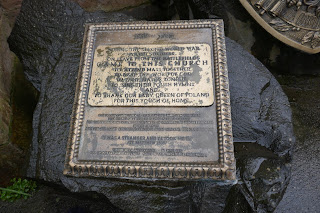






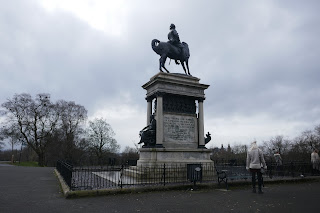























































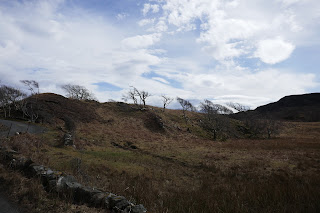




















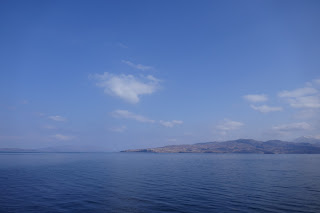





























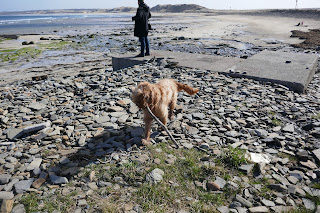
































No comments:
Post a Comment